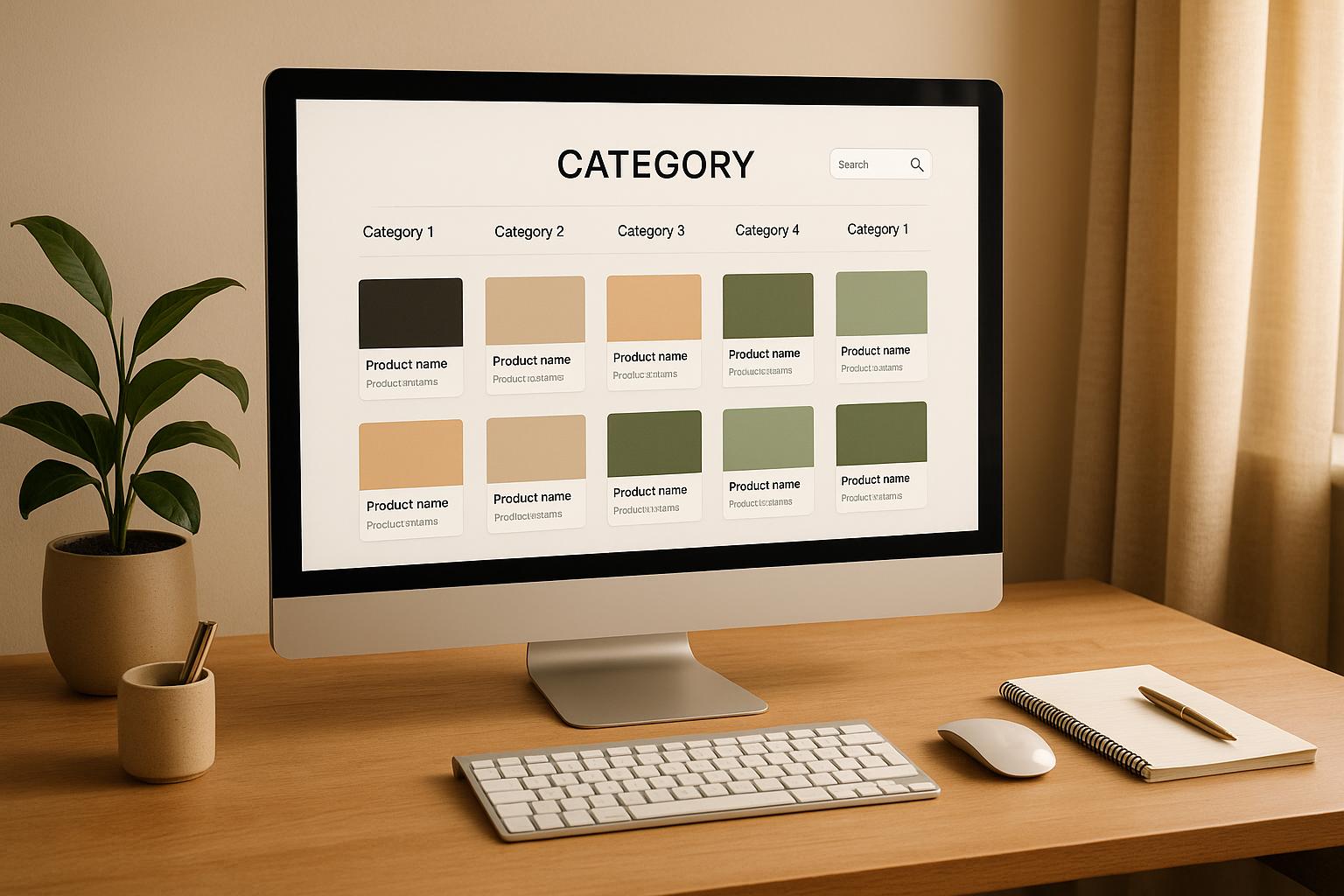Category pages are key for both improving search engine rankings and creating a better user experience. They help organize products, target high-volume keywords like "men’s running shoes", and make your website easier to navigate for both users and search engines. Here’s how to optimize them effectively:
- Focus on Keywords: Use long-tail keywords (e.g., "women’s waterproof hiking boots size 8") that match search intent – research, comparison, or purchase.
- Improve Page Elements: Write clear titles, meta descriptions, and category descriptions with relevant keywords. Compress images and use alt text to boost SEO.
- Enhance Internal Linking: Use breadcrumbs, clear navigation paths, and contextual links to connect categories and products.
- Technical SEO: Ensure fast load times, clean URLs, and proper schema markup. Use tools like canonical tags and XML sitemaps to avoid duplicate content and improve crawlability.
How To Optimize Your Category & Collection Pages For SEO | Kai Cromwell
Finding the Right Keywords
Choose keywords that resonate with your audience’s intent and support your business goals, all while sounding natural.
Matching Keywords to Search Intent
Understanding search intent is key to reaching users at different points in their journey. For example, research-focused phrases like "best running shoes for flat feet" attract users seeking information, while purchase-oriented terms such as "buy Nike Air Max men’s size 10" appeal to those ready to buy. To align with intent effectively, study your audience’s search habits by analyzing search engine results pages (SERPs) to see what type of content ranks for your target terms.
Here’s a quick breakdown of how keyword types align with user intent:
| Intent Type | Keyword Example | Best Used For |
|---|---|---|
| Research | "how to choose running shoes" | Informational content |
| Compare | "Nike vs Adidas running shoes" | Comparison sections |
| Purchase | "men’s running shoes sale" | Product pages |
This approach helps you zero in on keywords that match what your audience is looking for.
Using Specific Long-Tail Keywords
Once you’ve mapped keywords to intent, refine your strategy by focusing on long-tail keywords. These are highly specific phrases that directly connect with your audience’s needs. Instead of competing for broad terms like "shoes," aim for precise phrases like "women’s waterproof hiking boots size 8". Long-tail keywords often have less competition, drive more targeted traffic, and lead to better conversion rates.
To find these keywords, try tools like Google Keyword Planner or scan customer reviews for recurring phrases. You can also explore autocomplete suggestions and related searches at the bottom of SERPs for fresh ideas.
Placing Keywords in Headers
Incorporate your top keywords naturally into your page’s headers to improve structure and clarity. Use your primary keyword in the H1 tag and place related terms in H2 and H3 tags. For example, a cookware category might use this structure:
- H1: "Nonstick Cookware Sets"
- H2: "Professional Nonstick Pan Collections"
- H3: "Ceramic-Coated Cooking Sets"
Google relies on headings to understand your page’s context, so descriptive, keyword-rich headers tend to perform better than vague or overly creative ones.
Keep an eye on your keyword strategy‘s performance by tracking metrics like organic traffic, rankings, and conversions. Regularly refining your approach ensures your pages continue to draw the right audience and drive results.
Basic Page Elements to Optimize
Refining key elements on category pages can significantly improve search rankings and enhance the user experience. Here’s how to fine-tune some of the most critical components.
Writing Strong Titles and Meta Descriptions
To avoid truncation, keep title tags within 60 characters and meta descriptions under 155 characters.
Here’s a quick breakdown:
| Element | Character Limit | Best Practice Example | Purpose |
|---|---|---|---|
| Title Tag | 60 characters | "Women’s Running Shoes – Top Brands & Styles 2025" | Signals search relevancy |
| Meta Description | 155 characters | "Shop premium women’s running shoes from leading brands. Find the perfect fit with our size guide and expert recommendations. Free shipping on orders over $50." | Encourages click-throughs |
For maximum impact, place primary keywords at the beginning of title tags. Avoid generic descriptions and, instead, highlight unique features or benefits that set your page apart.
Creating Clear Category Descriptions
Category descriptions should strike a balance between keyword usage and helpful, user-focused content. These descriptions not only help customers make informed choices but also improve search engine visibility.
When crafting descriptions, consider including:
- The types of products available within the category
- Key features and benefits of the products
- Typical use cases or applications
- Any relevant sizing or compatibility details
Make sure this content is accessible to search engines by avoiding JavaScript-based hidden text. Tools like View Rendered Source can help confirm that all content is crawlable.
Optimizing Images and Alt Text
Images play a crucial role in both user engagement and SEO performance. Compress images to maintain quality while improving load times, as faster pages tend to rank better. Use responsive image techniques, like srcset, to deliver appropriately sized images for different devices.
For alt text:
- Keep it under 125 characters
- Naturally include relevant keywords
- Clearly describe what the image depicts
- Avoid vague terms like "product image"
For example, instead of "category banner", opt for something like: "Women’s running shoes collection featuring Nike, Adidas, and Brooks models." This approach not only helps search engines but also aids users relying on screen readers.
sbb-itb-880d5b6
Internal Links and Site Navigation
Internal linking helps create a clear site structure that benefits both search engines and users. Here’s how to optimize these connections for better navigation and usability.
Creating Clear Navigation Paths
A well-thought-out navigation system is essential for guiding users and search engines effectively. One way to enhance this is by implementing breadcrumb schema markup:
<script type="application/ld+json"> { "@type": "BreadcrumbList", "itemListElement": [{ "@type": "ListItem", "position": 1, "name": "Electronics", "item": "https://example.com/electronics" }] } </script> When structuring your navigation, stick to these proven patterns:
| Navigation Element | Purpose | Example of Best Practice |
|---|---|---|
| Main Menu | Highlights primary categories | Limit to 5-7 top-level items |
| Breadcrumbs | Tracks user location | Home > Category > Subcategory |
| Secondary Navigation | Offers filtering options | Price, Brand, Features |
| Footer Links | Highlights key categories | Links to popular sections |
These elements ensure users can easily find their way to product pages while helping search engines crawl your site more effectively.
Connecting Categories and Products
Strong internal linking between categories and products can significantly improve rankings for category pages. Here are some essential practices to follow:
Navigation Best Practices:
- Use specific, descriptive anchor text instead of vague terms like "click here."
- Keep the total number of links on a page under 100 to maintain link equity.
- Ensure all key pages can be reached within three clicks.
- Contextually link related categories (e.g., "Gaming Laptops" to "Gaming Accessories").
- Avoid orphaned pages and ensure JavaScript-based navigation is crawlable.
"According to Moz, a well-structured site hierarchy should not exceed three levels from the main category to a subcategory, supporting both SEO and usability".
Featured Products Section
Including a featured products section on category pages can also improve navigation and user engagement. Popular options include:
- Best Sellers
- New Arrivals
- Staff Picks
- Most Popular
This setup not only enhances the user experience but also helps search engines better understand the relationships between categories and products.
Technical SEO Requirements
Technical SEO ensures that search engines can easily find, understand, and index your category pages. Below, we’ll dig into the core aspects of technical setup.
Making Pages Easy to Find
To get search engines to crawl and index your category pages effectively, focus on these key elements:
| Technical Element | Purpose | Best Practice |
|---|---|---|
| Robots.txt | Manages crawler access | Allow indexing of category pages but block duplicate filters |
| XML Sitemap | Helps search engines discover pages | Include all primary category pages and use priority tags |
| Canonical Tags | Avoids duplicate content issues | Direct variations to the main category URL |
For canonical tags, use this simple structure for your category pages:
<link rel="canonical" href="https://example.com/category/electronics" /> Improving Page Load Speed
Once your pages are discoverable, speed becomes crucial. A fast-loading site not only improves user experience but also aligns with Google’s Core Web Vitals, which are key ranking factors.
Core Speed Metrics to Monitor:
- Largest Contentful Paint (LCP): Keep it under 2.5 seconds.
- First Input Delay (FID): Ensure it’s below 100 milliseconds.
- Cumulative Layout Shift (CLS): Aim for a score of less than 0.1.
To achieve these goals, implement the following:
- Optimize Images: Compress images and switch to modern formats like WebP.
- Minimize Resources: Reduce the size of JavaScript and CSS files.
- Enable Browser Caching: Cache static resources to speed up repeat visits.
- Use a CDN: Content Delivery Networks can significantly improve load times, especially for global audiences.
Adding Schema Markup
Structured data helps search engines better understand your pages and can make your results stand out in search. For example, adding schema to a product collection page might look like this:
{ "@context": "https://schema.org", "@type": "ProductCollection", "name": "Gaming Laptops", "description": "High-performance gaming laptops featuring the latest graphics cards", "numberOfItems": "25", "itemListElement": [ { "@type": "Product", "name": "Gaming Laptop Model X", "price": "1299.99", "priceCurrency": "USD" } ] } "According to Moz, implementing proper schema markup can increase click-through rates by up to 30% through enhanced search result visibility".
Conclusion: Main Points to Remember
To optimize category pages effectively, it’s essential to combine technical know-how with a user-first approach. A 2023 case study highlighted how an insulated drinkware company boosted organic traffic by 15% and organic revenue by 21% simply by updating eight category pages each month. These results can be distilled into three key areas of focus:
| Optimization Area | Key Requirements | Impact |
|---|---|---|
| Keyword Strategy | Seamless use of primary and long-tail keywords | Better search visibility and targeted traffic |
| Technical Setup | Fast load times, clean URLs, proper schema markup | Improved crawlability and indexing |
| Content Structure | Clear headings, optimized metadata, and descriptive text | Enhanced user experience and higher search rankings |
The technical side plays a foundational role – ensure your pages meet critical performance benchmarks, like Google’s Core Web Vitals. Aim for a Largest Contentful Paint (LCP) under 2.5 seconds and a Cumulative Layout Shift (CLS) below 0.1. These standards ensure your pages are fast, stable, and user-friendly.
FAQs
How do I find the best long-tail keywords for my category pages to match user search intent?
To find the best long-tail keywords for your category pages, start with thorough keyword research. Focus on specific phrases that are three or more words long and closely match the products or services you offer. Use keyword tools to evaluate search volume, competition levels, and how well these terms align with what potential customers are searching for.
After narrowing down your options, examine the search engine results pages (SERPs) for your chosen keywords. This step helps you understand user intent – whether people are looking for information, navigating to a specific site, or ready to make a purchase. Pay attention to recurring patterns, like frequently asked questions or common phrases, to fine-tune your content. By addressing these user needs, you’ll boost the relevance of your pages and improve their chances of ranking higher in search results.
How can I improve the loading speed of category pages for better SEO results?
To make your category pages load faster and improve SEO, focus on these practical strategies:
- Compress your images: Shrink image file sizes without losing quality and switch to modern formats like WebP for better efficiency.
- Use lazy loading: Delay loading images that aren’t immediately visible until the user scrolls to them.
- Streamline your code: Trim down JavaScript and CSS files, and eliminate any scripts or code that your page doesn’t actually need.
- Turn on browser caching: Allow static resources to be stored locally, so returning visitors experience faster load times.
- Keep layouts simple: A clean, straightforward page design reduces complexity and speeds up performance.
Quick-loading category pages not only create a smoother experience for users but also show search engines that your site is optimized, which can help improve your rankings.
How does adding schema markup improve SEO and click-through rates for category pages?
Adding schema markup to your category pages can boost your SEO by making it easier for search engines to interpret the content and purpose of your page. This structured data can trigger rich snippets – like star ratings, pricing details, or product availability – to appear right in the search results.
Rich snippets don’t just make your listing stand out visually; they also provide more useful information at a glance. This added visibility can grab attention and lead to higher click-through rates, ultimately driving more traffic to your category pages.




